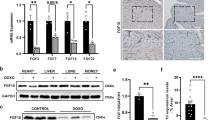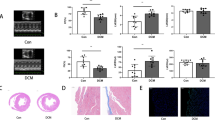Abstract
Doxorubicin is one of the most effective drugs available for cancer chemotherapy. However, the clinical use of doxorubicin has been greatly limited because of severe side effects on cardiomyocytes. Since Nd1-L, a novel actin-binding protein, is expressed most abundantly in the heart of adult mice, we examined a role of Nd1-L in doxorubicin-induced cardiomyopathy. When doxorubicin (5 mg/kg × 4 times) was injected into adult mice at a 3-day-interval, approximately 50% of injected mice died within 4 weeks of the first injection. Nd1-L mRNA expression in the heart decreased within 3 weeks after the first injection and many cardiomyocytes of injected mice died by apoptosis. Overexpression of Nd1-L in the heart of transgenic mice protected the cardiomyocytes from apoptosis and improved survival rate after doxorubicin injection. Furthermore, activation of Erk1/2 was observed in cultured cells overexpressing Nd1-L. Thus, Nd1-L plays a critical role in protecting the heart from doxorubicin-induced cardiomyopathy.
Similar content being viewed by others
References
Adams J, Kelso R, Cooley L (2000) The kelch repeat superfamily of proteins: propellers of cell function. Trends Cell Biol 10:17–24
Akiba H, Nakano H, Nishinaka S, Shindo M, Kobata T, Atsuta M, Morimoto C, Ware CF, Malinin NL, Wallach D, Yagita H, Okumura K. (1998) CD27, a member of the tumor necrosis factor receptor superfamily, activates NF-kappaB and stress-activated protein kinase/c-Jun N-terminal kinase via TRAF2, TRAF5, and NF-kappaB-inducing kinase. J Biol Chem 273:13353–13358
Bardwell VJ, Treisman R (1994) The POZ domain: a conserved protein–protein interaction motif. Genes Dev 8:1664–1677
Benjamin RS (1979) Adriamycin and other anthracycline antibiotics under study in the United States. Recent Result Cancer Res 63:230–240
Bueno OF, Molkentin JD (2002) Involvement of extracellular signal-regulated kinases 1/2 in cardiac hypertrophy and cell death. Circ Res 91:776–781
Carter SK (1975) Adriamycin—a review. J Natl Cancer Inst 55:1265–1274
Colombo R, Milzani A (1988) How dose doxorubicin interfere with actin polymerization? Biochim Biophys Acta 968:9–16
Franz WM, Muller OJ, Katus HA (2001) Cardiomyopathies: from genetics to the prospect of treatment. Lancet 358:1627–1637
Fujimura L, Matsudo Y, Kang M, Takamori Y, Tokuhisa T, Hatano M (2004) Protective role of Nd1 in doxorubicin-induced cardiotoxicity. Cardiovasc Res 64:315–321
Henderson IC, Frei E (1979) Testing for doxorubicin cardiotoxicity. N Engl J Med 300:310–312
Hernandez MC, Andres-Barquin PJ, Martinez S, Bulfone A, Rubenstein JL, Israel MA (1997) ENC-1: a novel mammalian kelch-related gene specifically expressed in the nervous system encodes an actin-binding protein. J Neurosci 17:3038–3051
Hogan B, Costantini F, Lacy E (1986) Manipulating the mouse embryo: a laboratory manual. Cold Spring Harbor Laboratory Press, Cold Spring Harbor
Ito H et al., (1990) Doxorubicin selectively inhibits muscle gene expression in cardiac muscle cells in vivo and in␣vitro. Proc Natl Acad Sci USA 87:4275–4279
Jiang S et al., (2005) Process elongation of oligodendrocytes is promoted by the Kelch-related actin-binding protein Mayven. J Neurochem 92:1191–1203
Kang YJ, Chen Y, Yu A, Voss-McCowan M, Epstein PN (1997) Overexpression of metallothionein in the heart of transgenic mice suppresses doxorubicin cardiotoxicity. J Clin Invest 100:1501–1506
Kang M, Matsudo Y, Sasagawa K, Tokuhisa T, Hatano M (2001) Nd1, a novel murine Kelch family protein, may play the role of a housekeeping gene. Biochim Biophys Acta 1519:167–174
Kim C, Nam SW, Choi DY, Choi JH, Park ES, Jhoo WK, Kim HC (1997) A new antithrombotic agent, aspalatone, attenuated cardiotoxicity induced by doxorubicin in the mouse; possible involvement of antioxidant mechanism. Life Sci 60:75–82
Kunisada K, Negoro S, Tone E, Funamoto M, Osugi T, Yamada S, Okabe M, Kishimoto T, Yamauchi- Takihara K. (2000) Signal transducer and activator of transcription 3 in the heart transduces not only a hypertrophic signal but a protective signal against doxorubicin-induced cardiomyopathy. Proc Natl Acad Sci USA 97:315–319
Lee V, Randhawa AK Signal PK (1991) Adriamycin-induced myocardial dysfunction in vitro is mediated by free radicals. Am J Physiol 261:H989–H995
Lefrak EA, Pitha J, Rosenheim S, Gottlieb JA (1973) A clinicopathologic analysis of adriamycin cardiotoxicity. Cancer 32:302–304
Myers CE, McGuire WP, Liss RH, Ifrim I, Grotzinger K, Young RC (1977) Adriamycin: the role of lipid peroxidation in cardiac toxicity and tumor response. Science 197:165–167
Philips J, Herskowitz I (1998) Identification of Kel1p, a kelch domain-containing protein involved in cell fusion and morphology in Saccharomyces cerevisiae. J␣Cell Biol 143:375–389
Robinson DN, Cooley L (1997) Drosophila kelch is an oligomeric ring canal actin organizer. J Cell Biol 138:799–810
Sanders MC, Way M, Sakai J, Matsudaira P (1996) Characterization of the actin cross-linking properties of the scruin–calmodulin complex from the acrosomal process of Limulus sperm. J Biol Chem 271:2651–2657
Sasagawa K, Matsudo Y, Kang M, Fujimura L, Iitsuka Y, Okada S, Ochiai T, Tokuhisa T, Hatano M (2002) Identification of Nd1, a novel murine kelch family protein, involved in stabilization of actin filaments. J Biol Chem 277:44140–44146
Swynghedauw B (1986) Developmental and functional adaptation of contractile proteins in cardiac and skeletal muscles. Physiol Rev 66:710–771
Tewey KM, Rowe TC, Yang L, Halligan BD, Liu LF (1984) Adriamycin-induced DNA damage mediated by mammalian DNA topoisomerase II. Science 226:466–468
Xue F, Cooley L (1993) Kelch encodes a component of intercellular bridges in Drosophila egg chambers. Cell 72:681–693
Yamamoto H, Hatano M, Iitsuka Y, Mahyar N, Tokuhisa T (1995) Two forms of Hox11, a T cell leukemia oncogene, are expressed in fetal spleen but not in primary lymphocytes. Mol Immunol 32:1177–1182
Young RC, Ozols RF, Meyers CE (1981) The antracycline antineoplastic drugs. N Engl J Med 305:139–153
Zhu W, Zou Y, Aikawa R, Harada K, Kudoh S, Uozumi H, Hayashi D, Gu Y, Yamazaki T, Nagai R, Yazaki Y, Komuro I (1999) MAPK superfamily plays an important role in daunomycin-induced apoptosis of cardiac myocytes. Circulation 100:2100–2107
Acknowledgments
We would like to extend our thanks to Drs. S. Okada and M. Kang for helpful discussion, H. Satake for her technical assistance, and N. Kakinuma for her secretarial assistance. This work was supported in part by a grant-in aid for scientific research from the Ministry of Education, Science, Sport and Culture of Japan.
Author information
Authors and Affiliations
Corresponding author
Rights and permissions
About this article
Cite this article
Matsudo, Y., Takamori, Y., Fujimura, L. et al. Overexpression of Nd1, a novel Kelch family protein, in the heart of transgenic mice protects against doxorubicin-induced cardiomyopathy. Transgenic Res 15, 573–581 (2006). https://doi.org/10.1007/s11248-006-9010-x
Received:
Accepted:
Published:
Issue Date:
DOI: https://doi.org/10.1007/s11248-006-9010-x




